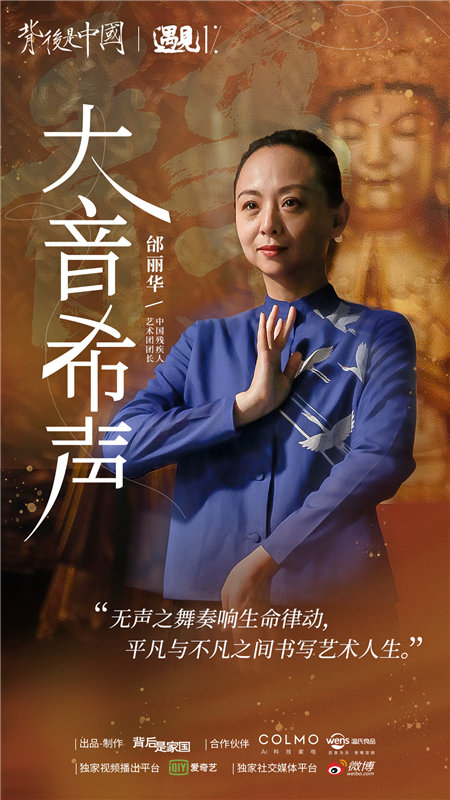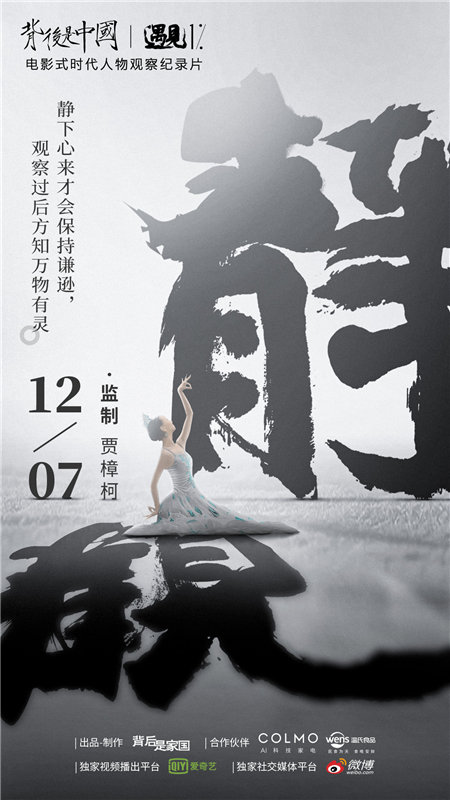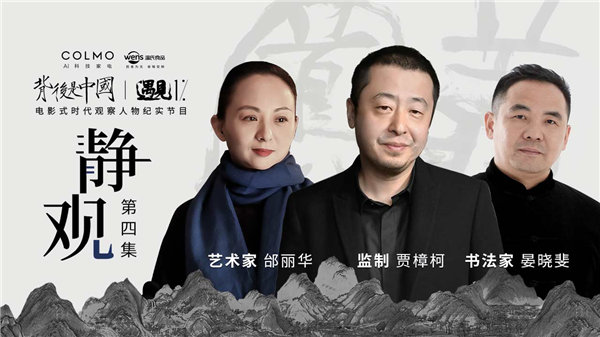There is indeed a kind of person in the world who never emphasizes the meaning of his life, but lives quietly but earnestly and hard.
-Truman Capote
The economy is constantly changing, information is sweeping through, and the busy life may reflect faster forgetting. How long have you not stopped to appreciate? How long has it been without meditation? Putting aside the prosperous appearance of the times, emptying the things outside of the body, and learning to observe quietly through the spiritual journey may be able to see the meaning of short life.
Director Jia Zhangke, in his latest documentary “Behind China·Meeting 1%”, “Quiet View”, is convenient for walking and reveries using dance, calligraphy and other paths to contemplate the world. Dialogue with dancer Tai Lihua and calligrapher Yan Xiaofei through lens language , Host Chen Jing. They settle down to explore the meaning of life, they sink down to discover the spiritual foundation behind artistic phenomena, and they tell the spiritual pulse of the times with a new way of resonance.
“Mindfulness”
Only when you calm down will you remain humble
After observing, we know that everything is alive
Da Yin Xi Sheng
The silent art and the beauty of the soul
Tai Lihua is the head of the Chinese Art Troupe for the Disabled. In the 2005 Spring Festival Gala, a dance performance called “Avalokitesvara of Thousand Hands” brought the audience an extremely shocking audiovisual and spiritual impact. As a deaf and mute person, Tai Lihua and her teammates performed flawlessly to express the perfection of artistic expression. The visual presentation of dance strengthened the beauty of “Thousands of Hands and Thousands of Eyes” with particularity. This holistic vigor and artistic form of charm also implies behind it. Their pursuit of the beauty of life.
“Everything has cracks. That’s where the light comes in.” In the show, Tai Lihua recalled the scene when she first learned to dance: “I can’t forget the day when the teacher took my little hand and led me to a paved floor. In the wooden floor classroom, the teacher is playing the piano while beating the rhythm on the elephant drum. The vibration of the drum is transmitted to the soles of my feet through the wooden floor. I seem to hear the most beautiful melody and music in the world.” The special rehearsal method opened up Tai Lihua’s artistic soul, and the dance illuminates her life journey like a beam of light.
Now, Tai Lihua plays a pioneering role in the dance art of the deaf and mute in the art troupe. She is always the first to step into the rehearsal room at the beginning of Chaoyang. The success of “Avalokitesvara Avalokitesvara” also inspired countless disabled dancers to embark on the artistic path. In the program, Tai Lihua guided the deaf-mute dancers in the art troupe to dance with the vibration of the drum, which means that a certain kind of inheritance is more representative A new beginning.
Perhaps the most beautiful voice in the world is the “big sound”. The new generation of deaf-mute artists are listening to their beautiful music with solemn expressions. In the dance of their bodies, they use finite expressions to express infinitely. There is a clear and beautiful mind in the world. Tai Lihua seemed to see herself in them, traversing the sound and silent boundary monuments, crossing the past and the future, talking here, listening here, expressing here, and conveying moving artistic care here.
Jia Zhangke commented: “When you meet beauty in dance, you feel not the regret of incompleteness, but the shock of the soul.” Looking at the new generation of disabled artists, silent dialogue, solemn expression, and equal pursuit of artistic beauty. , This is about the past, but more about the future.

Calligraphy comes from the heart
Only when the bamboo is on the chest can it be brushed with pen and paper
“Take agarwood, respect friends, agarwood connects the three realms, smells the fragrance, there is ink fragrance, there is the sound of piano and tea.” Yan Xiaofei was in his tea room “Xuan Da Ju” and talked about his artistic mentality with friends at Yicha.
Yan Xiaofei, a contemporary Chinese calligrapher, as a new generation of artistic figures in Huxiang culture, Yan Xiaofei always has the art of calligraphy in mind. In 2006, he went to Beijing to “North Drift” alone, determined to walk on the road of contemporary Chinese calligraphy research. Yan Xiaofei copied a variety of classical scripts, including “Sage” Wang Xizhi, “Song Sijia” Su Shi, Mi Fu, and even Dong Qichang and Wang Duo. At the same time, he has studied various styles such as seal script, official script, regular script, and cursive script.
Calligraphy comes from the mind. The ancient humanity “words are like the person”. Calligraphy presents a person’s inner spiritual temperament. It is an introspective artistic consciousness to break through calligraphy skills through inner excavation. After spiritual wandering, he can become a cultural walk. Yan Xiaofei has a deep understanding of this point. He introduced “Ancient Method of Writing” in the program: “I think the most important point in this calligraphy is the use of pens; there are twenty-four days. In solar terms, people have twenty-four ribs, five thieves in the sky, and five elements in the earth. In fact, people have five sons. These five sons actually correspond to the five elements.
Holding a pen and sneaking into the vast smoke waves of Chinese culture, he uses his pen to search for the artistic life hidden in it: “The root, the belly, and the tip of the pen are also equivalent to the three parts of life.” Yan Xiaofei described his understanding of life and life with his brushwork. Spiritual practice.
“When you stand at thirty, you must first stand up. After you stand up, the pen must be able to be picked up and put down, just like doing things in life. We are now in contact with society. We know that there are many good things in society, as well as many unfathomable things. Therefore, it is like the belly of a pen full of water and ink. When the front is walking, things in the stomach will come out, so the lines appear very full.”
“When I meet Tao in calligraphy, I feel not only the end of the dragon and snake, but the insignificance of my self.” Cheng Zhu can only use pen and paper on his chest, travel between ancient and modern, and dialogue with the world, ancient and modern, Yan Xiaofei explores with calligraphy With the resonance and the same frequency in my heart, I look at my life in contemplation, looking for the philosophies and answers of life.

There are also common spiritual cores between different art categories. Tai Lihua is in the sound and silent, Yan Xiaofei is in the writing and writing, the host Chen Jing is on the border between the modern and the old in the city. Tao in heart.
Jia Zhangke said in “Behind China·Meeting 1%”: “Walking and reverie will help us clear out the things outside of the body. Only when we calm down will we remain humble. Only after observation will we know that everything is alive.” What’s behind? After watching the show, we seem to have found the answer: perhaps it is the inner “memory”, it can be a dance, a calligraphy and painting, a city, and even mountains and rivers.

[
责编:杨帆 ]
.
